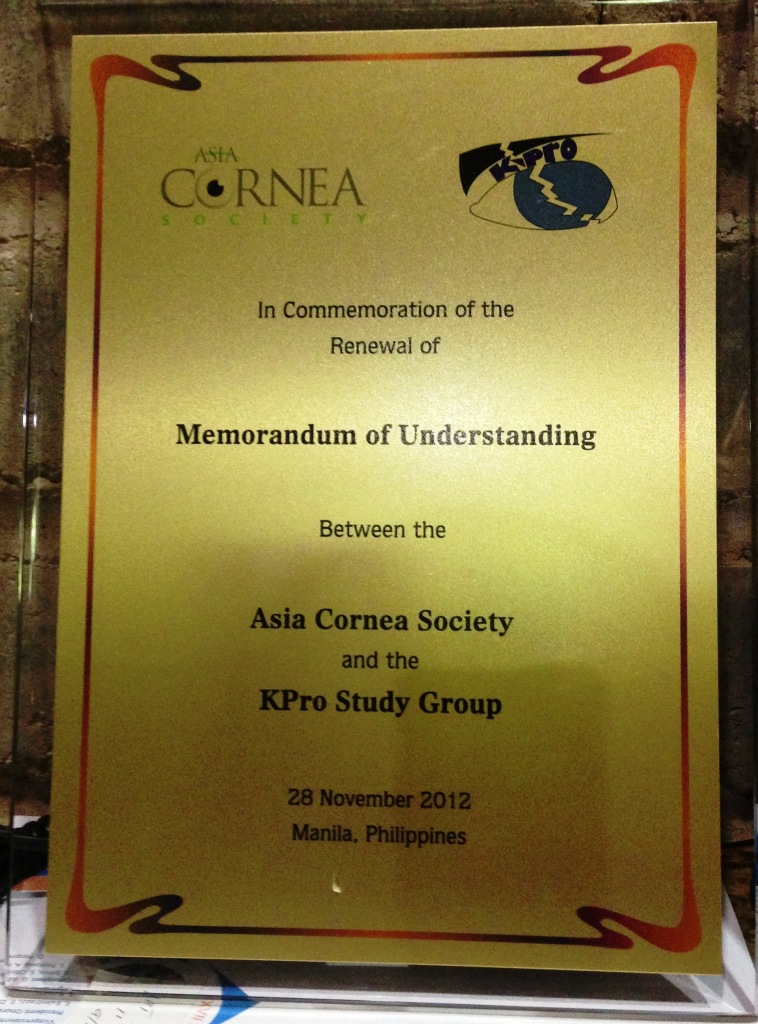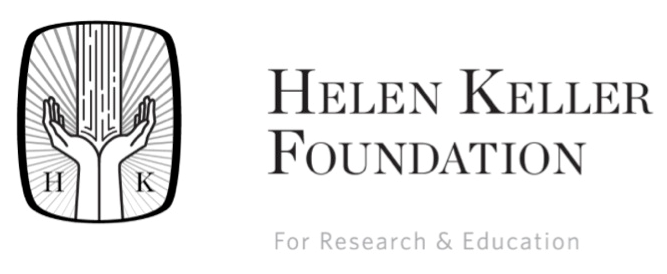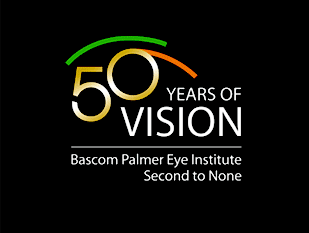Words from Dr. Robert Morris
August 1, 2016 by · Leave a Comment
August 4, 2016
Dear Colleague,
The Helen Keller Foundation for Research and Education is interested in sponsoring a clinical trial in pursuit of a reliable surgical method of achieving long-term prevention for rhegmatogenous retinal detachment (RRD) in KPro eyes. RRD in KPro eyes is currently reported to have a 7 year cumulative incidence of 19%,1 and (largely due to an obscured peripheral retina), only a one third chance of successful reattachment with return of improved vision after RRD surgery.2
We would like to hear from active KPro centers as to possible interest in such a clinical trial, as well as to receive comments regarding this proposal. The surgical technique to be studied involves placement of a (wide field) temporary keratoprosthesis (TKP) to allow both closed vitrectomy* and peripheral, encircling laser (RRD) prophylaxis**, followed immediately by removal of the TKP and placement of a permanent KPro, in a single procedure.
One patient so treated in his left eye had lost his right eye to RRD 14 months after otherwise successful KPro surgery. In contrast, his left eye is now 45 months postoperative, with a stable retina (visual acuity of 20/100 distance, 20/25 near, using a low vision aide). (See video link below).
If a clinical trial were confirmatory, consecutive TKP vitrectomy/laser prophylaxis and KPro placement could be used in a subset of KPro patients who have especially high risk factors for RRD, or who are monocular, or it might ultimately be elected as a routine part of KPro placement.
Please review our poster from the 2015 Retina Society meeting and the 2014 meeting of the KPro Study Group (see poster link below). If you find this concept to have merit, kindly make us aware of other KPro surgeons you would recommend, who might also have interest. Thank you for your attention and we look forward to receiving your confidential comments.
Robert Morris MD
President Helen Keller Foundation For Research and Education rmorris@retinanetwork.com rmorris@rmeyes.com (personal)
* TKP enabled vitrectomy has the additional benefit of “last chance” inspection of the entire retina before the periphery is obscured by KPro placement. Complete vitreous removal also prepares the eye for a pars plana shunt that may be simultaneously installed; clears vitreous hemorrhage emanating from trephination of a vascularized cornea; prevents postoperative vitreous opacities commonly associated with sterile vitritis in KPro eyes; allows removal of any epimacular membranes; and prevents future vitreoretinal traction resulting from an uncontrolled posterior vitreous detachment event, when retinal visualization through the KPro has again been compromised. Moreover, the post vitrectomy eye is more amenable to treatment of posterior inflammation by topical treatment.
** Peripheral encircling laser treatment has been widely adopted in recent years as an effective prophylaxis against RRD.
Links:
RD Prevention in Opaque-Cornea Eyes Receiving KPro (video)
RD Prevention in Opaque-Cornea Eyes Receiving KPro (poster)
References:
1. Srikumaran D, Munoz B, Aldave AJ, Aquavella JV, Hannush SB, Schultze R, Belin M, Akpek EK. Long-term outcomes of Boston type 1 keratoprosthesis implantation. Ophthalmol 2014; 121:2159-2164.
2. Klufas MA, Yannuzzi BA, D’Amico DJ, Szilard K. Vitreoretinal aspects of permanent keratoprosthesis. Surv Ophthalmol 2015; 60(3):216-228.
Retinal Detachments in Eyes After Boston Keratoprosthesis Type 1
April 10, 2014 by · Leave a Comment
Download (pdf)- KPRO Retinal Detachment Poster Jain-Chau et al 9th Kpro Meeting Austria April 2014
Treatment Outcomes of Cystoid Macular Edema in Patients with Boston Type I Keratoprosthesis
April 10, 2014 by · Leave a Comment
Download (pdf)- KPro-Cystoid Macular Edema poster Miller-Chau et al 9th Kpro Meeting Austria April 2014
2nd generation MOOKP micro-Mill
April 4, 2013 by · Leave a Comment
2nd generation MOOKP MicroMill rev 3.31.13 ,for more information, contact abernal@bioniko.com
Advances in Modified Osteo-Odonto Keratoprosthesis Technique for the treatment of Combat Related Corneal Blindness
April 4, 2013 by · Leave a Comment
MOOKP – Military Vision Symposium on Ocular & Vision Injury 09-14-12 FINAL
Memorandum of Understanding between the Asia Cornea Society and the KPro Study Group
February 26, 2013 by · Leave a Comment
 We also have a renewed Memorandum of Understanding between the Asia Cornea Society and the KPro Study Group
We also have a renewed Memorandum of Understanding between the Asia Cornea Society and the KPro Study Group
OBJECTIVE
This Memorandum of Understanding (MOU) expresses the general understanding and intentions of the ACS www.asiacorneasociety.org and KPro Study Group concerning affiliation. The purpose of this affiliation is to link up both societies to establish a global network of corneal subspecialists and researchers with the common vision of fostering the exchange of knowledge and information on clinical, educational and research aspects of the corneal subspecialty dedicated to the advancement of corneal subspecialty.
Boston Keratoprosthesis Update
September 24, 2009 by · Leave a Comment
*revised 02/26/2013
Standards for Modified Osteoodontokeratoprosthesis (OOKP) Surgery According to Strampelli and Falcinelli
Konrad Hille, MD, Gunther Grabner, MD, Christopher Liu, FRCOphth, Paolo Colliardo, MD, Giovanni Falcinelli, MD, Maurizio Taloni, MD, and GianCarlo Falcinelli, MD
MOOKP Rome-Vienna Protocol 2005 -PDF
Intraocular pressure sensors in KPro
Samir Melki, MD, PhD, Miguel Lopez, MD and Claes Dohlman, MD, PhD
download– PDF
Etiology of Keratoprosthesis Loss: Results from The Boston Keratoprosthesis Multicenter Study
August 24, 2009 by · Leave a Comment
Health Resources Commercial Ventures
May 21, 2008 by JMP · Leave a Comment
Health Resources:
http://www.fda.gov/cdrh/ode/1351.html
Commercial Ventures:
Royal College of Ophthalmologists Study Tour to China
Survey
KPro Survey – Interim results to 31.8.2001 – ![]() PDF 97KB
PDF 97KB
Links
April 28, 2008 by JMP · Leave a Comment
*revised 02/26/2013
Bascom Palmer Eye Institute – USA
Bascom Palmer Eye Institute has earned an international reputation as one of the premier providers of eye care in the world and is consistently ranked among the top two eye hospitals in the United States. Bascom Palmer is the largest ophthalmic care, research and educational facility in the southeastern United States. More than 200,000 patients are treated each year with nearly every ophthalmic condition and 10,000 surgeries are performed annually. Bascom Palmer Eye Institute has served as the Department of Ophthalmology for the University of Miami School of Medicine since its founding in 1962. Over the past 10 years, Dr. Eduardo Alfonso has implanted a series of Dohlman KPros in Bascom Palmer patients and Drs Jean-Marie Parel, Eduardo Alfonso, Emmanuel Lacombe, Bernard Duchesne have designed a novel supra-Descemetic Synthetic Cornea (the Keralia) they experimentally tested together with Drs Josef Stoiber, Stephan Kaminski, Vivana Fernandez, Peggy Lamar and the team of the Ophthalmic Biophysics Center (OBC). In May 2003, the OBC team obtained EC approval for the Keralia and Phase I clinical trials that have begun January 2004 in Paris, Liege, Salzburg and Vienna. The first patient was successfully implanted on January 30, 2004 at the Liege University Hospital Center in Belgium. For additional information about Bascom Palmer Eye Institute visit the website at www.bascompalmer.org
Centro de Oftalmología Barraquer – Spain
The “Centro de Oftalmología Barraquer” is an independent, private entity, dedicated to the investigation, prevention, diagnosis, treatment and follow-up of eye diseases. It offers assistance to patients from all over the world, about 6.000 operations are performed annually in its operating rooms. Its teaching arm, the Instituto Barraquer, is a self-supporting scientific organization dedicated to the investigation, teaching and promotion of high quality ophthalmology, the exchange of scientific ideas, discoveries and innovations for improvement of surgical and medical therapy. Professor Joaquín Barraquer is a pioneer in the field of corneal surgery. He inserted his first keratoprosthesis in 1955 (Dorzee model) which was retained for 5 years. Other models were used over the years, but since 1963 Strampelli’s Osteo-Odonto-Keratoprosthesis is the technique of choice, a procedure which, after certain modifications, continues to be used at present by Professor Barraquer’s associate, Dr.Temprano, in selected cases at the “Centro de Oftalmología Barraquer”. The Proceedings with the extended abstracts of the past Kpro Study Group Meetings (1999, 2001, 2002, 2003) and a complete, up-dated bibliography on keratoprostheses and related subjects have been published in the “Anales del Instituto Barraquer “. For further information: http://www.barraquer.com
IOSS – International Ocular Surface Society – USA
IOSS is a non-profit organization for members to gain new experience and skills in treating ocular surface disorders. The society is devoted to promoting knowledge and skills of diagnosing and treating ocular surface and tear disorders. www.ioss.org
The Vision Cooperative Research Centre is a unique worldwide collaboration of over 30 organisations who have come together to deliver business growth and better eyecare for Australia and the world, by developing breakthrough technology and products for the correction of myopia and presbyopia; delivering innovative education programs at all levels of the eyecare industry; and developing models which provide effective, affordable, and sustainable eyecare delivery to communities in need. VCRC has four research program areas: Myopia and Presbyopia; which have been identified as key areas of opportunity in eyecare; and Vision Care Delivery and Business Growth, which will provide the essential support needed to ensure market development. Within the Myopia Program, one of the key projects is the development of a corneal onlay, based on the implantation of a synthetic lens made from a highly porous perfluoropolyether to bring about a change in the shape of the corneal surface, thereby achieving the desired refractive correction. The multidisciplinary VCRC approach includes optometry, ophthalmology, vision science, clinical science, epidemiology, microbiology, biochemistry, biostatistics, materials science, precision optical and biomedical engineering, polymer and surface chemistry, physiology, vision care delivery, business, and social and behavioural sciences. The Vision CRC is also committed to the delivery of quality education and training to postgraduate students, eyecare professionals and industry in Australia and internationally. Through the development and delivery of multidisciplinary educational courses and materials for both Academic and Professional education, the Vision CRC aims to produce high quality researchers for industry and science; well trained practitioners who are able to use high-technology products and to optimise and expand their business; and industry staff with the skills to improve customer service. www.visioncrc.org & www.brienholdenvision.org






